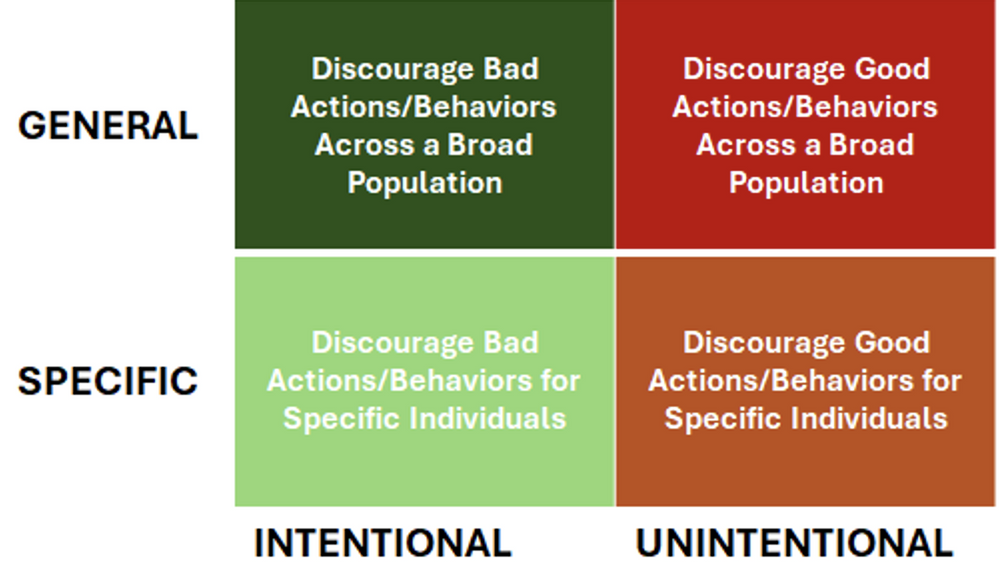Maritime Security
Deterrence
Applying and Measuring Deterrence – to Maritime Security and More
By Bert Macesker, David Walker, and Dr. Joe DiRenzo
When the word “deterrence” is used its context may be narrow, e.g., to deter a specific behavior, or more broadly focused to represent significant collective efforts and complexities, e.g., in support of the National Defense Strategy. The Cold War strategy of Mutual Assured Destruction (MAD) is a conceptual benchmark held by many when deterrence is discussed. The simplicity of this concept is in drastic contrast to the complexities and investment that it takes a nation to threaten annihilation to deter an attack.
Another common conceptual benchmark is to prevent recidivism in law enforcement by punishment that will deter future criminal behavior. There are many foundational articles on strategic and tactical deterrence in current literature. This article provides a discussion of deterrence through the lens of maritime security. It offers informal and formal uses, perspective on where the maritime community is today in applying deterrence, where opportunities may exist to apply deterrence principles in non-traditional ways, and a conceptual framework for thinking about any deterrent problem.
In August 2024, the United States Coast Guard held a workshop at Naval Support Activity Annapolis focused on deterrence. Participants came from 14 federal government agencies, two state agencies, five academic institutions and six industry groups. For the purposes of this workshop, deterrence was defined as “displacing or delaying unwanted behavior through proactive measures.” In practice, deterrence aims to discourage an individual or individuals from such behavior. An effective deterrence strategy rewards “good behavior” and punishes “bad behavior.” The authors of this article led one of the groups and lean on some of the discussions summarized in the Final Report (USCG Deterrence Evergreen, November 2024, submitted to Defense Technical Information Center (DTIC) as a public document in December).
Deterrence Applications in the Maritime Sector
Deterrence is currently applied intentionally and unintentionally by government, industry, and stakeholders across many facets of the Marine Transportation System (MTS) and maritime communities, including recreational boaters, to achieve desired outcomes. The authors suggest that deterrence is applied in the fundamental ways shown in Figure 1 in any number of environments, including the maritime domain.

Deterrence theory differentiates specific deterrence and general deterrence. Specific deterrence focuses on the behavior of an individual, generally targeting modification of specific behavior of an actor. An example is the deterrent effect that an individual driver feels after receiving a speeding ticket, now being more careful to avoid fines and other penalties. General deterrence focuses on the behavior of a broader audience, generally using actions or policies to modify behaviors of a whole community of actors. An example is the deterrent effect that police patrols serve to modify a wide range of poor driving behaviors for all drivers in an area. Deterrence can be a very targeted or a more general strategy.
In reality, deterrence is at work in a great many situations – often as an intentional tool to encourage positive behaviors and outcomes but sometimes as an unfortunate unintentional effect of discouraging positive behaviors and outcomes. The intentional application of deterrence is the focus of this paper, but readers should consider that deterrence can unintentionally affect behaviors. Examples of unintentional deterrence are (1) having overly complicated processes for reporting issues/concerns/threats or carrying out work processes that discourage well-meaning people from sharing information or executing work as intended and (2) exposing good actors to new risks/liabilities for taking positive actions (retaliation, legal liabilities, etc. for their actions). Deterrence can be a powerful force influencing both positive and adverse outcomes, so organizations are wise to be intentional in evaluating the impact deterrence can have on their missions.
The efficacy of deterrence as a strategy to mitigate illegal activities, such as poaching, has been a topic of considerable debate in the fields of conservation but also law enforcement. A recent study by Xu et al. (2020) employed a game-theoretic approach to investigate the impact of increased patrols on poaching activity in Queen Elizabeth National Park, Uganda. Xu et al developed a machine learning-based model, called PAWS (Protection Assistant for Wildlife Security), which utilized data on patrol routes, poaching incidents, and wildlife populations to predict poaching hotspots and optimize patrol routes. The results of the study indicated that strategic patrols, targeted at high-risk areas, can be an effective deterrent against poaching. This approach, although focused on a national park has a direct connection to the “value” of deterrence in a maritime environment. Substitute the term “national park” to “exclusive economic zone” or “poaching incidents” with “maritime drug trafficking organization shipment routes”.
In the Deterrence Evergreen workshop, it was discussed that there is ample anecdotal evidence of deterrence’s use and impact in the Coast Guard. As expected, there is a deterrence nexus across all Coast Guard mission areas. Obvious examples include passive and active deterrence activities to: protect infrastructure through continuous monitoring, patrols, and security measures to thwart terrorist attacks; disrupt drug trafficking operations through visible patrols, surveillance, and interception efforts ; and prevent illegal immigration by maintaining a strong maritime presence along maritime boundary lines. Less obvious examples include promoting safety and preventing accidents through education and outreach; mariner communication of safe navigation routes in our waterways; and communicating ice conditions to deter or reroute vessels that might otherwise operate in hazardous conditions. The following provides examples of opportunities and applications of deterrence related to Coast Guard missions and operations as well as those of maritime operators in the marine transportation system.
-
Transportation and Worker Safety Incidents. Transportation safety incidents include collisions, allisions, groundings, fires/explosions, and hazardous material releases/spills involving vessels. Worker safety incidents deal with the wide range of onboard worker safety incidents for vessel and facility operators such as slip/trip/fall injuries, cuts, injuries related to potential or kinetic energy, exposure to hazardous environments, and even exposure to pathogens in work activities. The Coast Guard in partnership with other federal, state/local, and international agencies and organizations have a comprehensive set of regulations and enforcement activities aimed at preventing these incidents. However, much like highway traffic, the number of vessels, operations, facilities, and workers stretches inspection and enforcement resources, even when third-party recognized organizations are used to support the safety mission. Specific deterrence is important for enforcing consequences for violating rules and policies resulting in safety incidents so that repeated events do not occur, but general deterrence is a force multiplier that helps strengthen overall industry compliance and the effectiveness of the safety net against incidents. Example opportunities with general deterrence related to safety incidents:
-
Public safety campaigns that emphasize the costs and impacts of safety incidents on both commercial operations and individuals.
-
Targeted inspection and audit programs providing higher likelihoods that operators with non-conforming safety programs receive the most attention and enforcement action.
-
Recognition and preferences for commercial operators that can demonstrate, with objective evidence, that their safety management systems and overall safety culture are performing at the highest levels.
-
Ensuring that Coast Guard presence at public security gatherings, such as Area Maritime Security Committee (AMSC) meetings, are used to re-enforce that targeted facility and vessel inspections will be employed based on risk.
-
-
Boating Safety Incidents. Boating safety incidents are particularly challenging for the Coast Guard and state/local agencies with boating safety responsibilities and authorities. Despite well-established regulations and availability of training and education programs, non-conforming behaviors and equipment continue. Resources for enforcement are limited, so general deterrence across the boating safety community is critical for driving compliance and safety. Example opportunities with general deterrence related to boating safety include:
-
Public safety campaigns that emphasize the costs and impacts of safety incidents, especially around failing to wear life jackets and boating under the influence.
-
Increasing reach of boating safety inspections with Coast Guard Auxiliary courtesy inspections that raise awareness of requirements and potential penalties for non-compliance.
-
Boating safety training requirements supported by Coast Guard Auxiliary, state/local agencies, non-profit organizations, and commercial providers.
-
Systems for reporting observed unsafe acts with follow-up by appropriate agencies, making the entire boating community an element of the enforcement community and a deterrent to bad behaviors.
Perhaps the best, most visible, on-going use of general and intentional deterrence activities within the Coast Guard are the Vessel Safety Checks (VSCs) performed by the Coast Guard Auxiliary. The Coast Guard Auxiliary VSC program is a voluntary, free inspection program conducted by the Auxiliary to promote boating safety and compliance with federal and state regulations. The program aims to educate boaters on safety equipment and best practices, thereby reducing the risk of accidents and promoting a culture of safety on the water. The program includes, free inspections, safety equipment verification, compliance with regulations, and education and outreach. The outcome of these deterrence activities, especially in locations with high concentrations of recreational boaters, include reduced risk of accidents and increased compliance. Most boaters maintain their vessel(s) in a safe and seaworthy condition, reducing the likelihood of non-compliance with regulations.
-
-
Maritime Physical Security and Cybersecurity Incidents. Physical and cybersecurity threats remain an important risk management issue for the Coast Guard’s prevention missions and Cyber Command and its agency/industry partners (such as DHS CISA, DOD, and various state/local agencies). Security risk management involves understanding threat, vulnerability, and potential consequences of security incidents. Threat assessment depends strongly on the capability and intent of an adversary to cause a security incident. Deterrence measures have a strong impact on intent by affecting the adversary’s perception of whether a potential attack could result in desired impacts, how likely an attempt might be to succeed, how likely they might be to get caught and how severe the consequences might be, and whether the complexity and resources required to carry out an attempt might be worth the effort. Figure 2 illustrates the Coast Guard in action executing its Ports, Waterways, and Coastal Security (PWCS) mission. Example opportunities with general deterrence related to security incidents include:
-
Actions taken to reduce the actual or perceived vulnerabilities of systems/assets and/or the potential consequences of incidents to make attempts unattractive.
-
Dedicated campaigns against criminal organizations and terrorist groups with indications of interest in causing maritime security incidents.
-

-
Facility, Vessel, and Infrastructure Management Failures. Facilities, vessels, and marine transportation system infrastructure (bridges, piers, jetties, aids to navigation, etc.) must be reliable to support maritime commerce. These very expensive assets require regular maintenance to realize their full life expectancy. However, because degradation and failures often occur over a long period of time, sustaining these assets is often overlooked or deferred, sometimes with catastrophic results. Deterrence can be applied to behaviors that would defeat planned asset management strategies. Example opportunities with general deterrence related to asset management issues include:
-
Using asset management systems that track completion of planned maintenance/sustainment activities and conditions of assets with management reporting can help deter overlooked or deferred action on critical assets.
-
Penalizing rather than rewarding asset management strategies that emphasize “firefighting” repair/replacement of damaged assets over preventing failures in the first place.
-
-
Human Resource Management Issues Maritime operators (including the Coast Guard) deal with a wide range of human resource management issues throughout their organizations. Recent high-profile concerns about sexual assault and sexual harassment concerns in the maritime industry are an example, but the range of issues includes theft, other forms of harassment, and other types of policy and procedure violations. Deterrence initiatives are important behavior modification tools that can be helpful. Example opportunities with general deterrence related to human resource management issues include:
-
Creating reporting and response tools and processes that anyone can use to report concerns/issues, effectively making the entire organization an enforcement resource.
-
Building incentives on how to intervene in non-conforming behavioral problems to encourage organizational action even when it might involve personal or career risk to engage.
-
It is important to note that deterrence efforts depend on influencing behaviors not only because of actual prevention and response measures in place, but mostly on a potentially bad actors’ perception of the robustness of prevention and response measures. Deterrence can significantly benefit from the perception of the robustness of the activities being conducted as much as the actual activities themselves including strong prevention and response measures.
Deterrence Implementation Challenges
Clearly, “deterrence” permeates a great many facets of MTS and maritime security.
-
But how do we know our deterrent activities are effective?
-
What tools do we use?
-
Is the desired deterrence effect short-term to address a specific threat or continuous?
-
Should physical or passive deterrence or a combination be used?
-
How do we measure/monitor it, or at a minimum know what deterrence success is?
-
What level of effort/investment should we make?
By far the worst thing government can do is put into place costly deterrence activities that have little to no impact on outcomes. The participants in the Deterrence Evergreen workshop concluded that while the Coast Guard was having a deterrence impact it did not have the capability (data, models, expertise) to directly measure it. Despite the lack of meaningful measurement, the participants felt there are near- and long-term opportunities that can be explored, primarily those created by big data analytics and Artificial Intelligence (AI). For example, Generative AI is being developed across private and government sectors. This includes the Microsoft sponsored ChatGPT, Army GenAI, and Air Force NIPRGPT. AI has the potential to help address challenging deterrence problems with analytic abilities for threat detection and monitoring. Certainly, the use of data collection and AI raise ethical questions, especially when applied to societal patterns of life.
The Coast Guard developed the Risk-based Decision-making (RBDM) Guidelines for Maritime Security after the 9/11 attacks. At the time it was developed, the tools focus did not factor in competing objectives like game theory --- which is often an approach employed for behavioral deterrence. Instead, it focused more on practical security risk profile and a one-dimensional attack model. Although, there exists literature that suggests the “threat” variable used in security risk profiling represents an implied reflection of the adversary’s behavior.
Post 9/11, deterrence activities and their effects were also part of the discussion involving the creation of the Port Security Risk Assessment Tool (PSRAT) and the follow-on Maritime Security Risk Assessment Model (MSRAM), currently used in our nation’s ports. However, deterrence was neither formally defined nor quantified. The Coast Guard RDC’s post 9/11 work with the University of Southern California explored deterrence in several risk management strategies. While field pilots tested some concepts the actual impact of “presence” on “deterrence” was not quantified.
The advent of large language models (LLMs) coupled with AI offer the potential for a more sustainable and meaningful way to measure deterrence in the future. The costs of implementing AI-driven LLMs is currently out of reach for most organizations but academia and the three-letter agencies have the expertise and resources that can apply cooperative game theory and AI to deterrence challenges. Still, waiting for the perfect and affordable deterrence model to come along is not the answer. The authors believe that there are many deterrence focused activities that could benefit from less resource intensive solutions to achieve a measurable impact.
Notional Deterrence Framework
What follows is a notional framework that adapts the RBDM process steps to help address, or at least deliberately think though, deterrence challenges. A conceptual example application is included.
Step 1: Establish the Deterrence Outcome
Step 1a: What is the deterrence goal?
Description: Describe the deterrence goal (outcome), e.g. to prevent non-compliance or adversary action. Is the desired deterrence effect short-term to address a specific threat or continuous?
Example: Cargo theft is a serious issue in the marine industry. Specific concerns include pilfering, shipping container theft, and theft from fraud. The owner/operator of a shipping company wants to increase deterrence of cargo theft from its containers/warehouses.
Step 1b: Who are the stakeholders?
Description: Identify and solicit involvement from key stakeholders who (1) will be responsible for implementing the deterrence strategy and (2) will be impacted by the deterrence activities.
Example: Shipping company owner/operator, law enforcement, internal security personnel, human resources, and insurance company.
Step 1c: What are the options available to the decision maker?
Description: Describe the choices available to the decision maker. This will help focus efforts only on issues likely to influence the choice among credible alternatives.
Example: The owner/operator decided that the following options were available to the decision maker:
-
Increase investment in current strategies.
-
Transfer liability of certain aspects of its operation.
-
Implement new strategies that can include both technological and non-technological solutions.
Step 1d: What are the factors that will influence the decision (including risk factors)?
Description: The decision to implement a deterrence strategy will require consideration of many factors, including costs, schedules, risks, etc. The stakeholders must identify the relevant factors.
Example: The owner/operator identified the following factors:
-
Up-front affordability of the deterrent solutions.
-
Costs to measure deterrence.
-
Supply chain delays.
-
Impact on insurance rates.
-
Company theft metrics.
-
Impact on industry reputation.
-
Personnel safety.
Step 2: Establishing the Deterrence Approach
Step 2a: What are the specific deterrent effects and available investment resources?
Description: Decide on the specific deterrent effects (objectives) that will support the overall deterrence goal (outcome). The desired deterrent effects chosen will be driven by resources (staff-hours, costs, etc.) available. A risk assessment may be needed to help prioritize the operations that would most benefit from enhanced deterrence.
Example: After conducting a risk assessment of cargo operations and determining the level of resources available, the owner/operator decided to narrow its deterrence focus on insider threats to company theft.
Step 2a: What is the deterrence measure(s) concept of operations?
Description: Select the deterrence approach/tactics that will produce the desired outcome. The deterrence approach(s) taken should have efficacy, feasibility, and be cost effective.
Example: The company decided to enhance it security presence in the warehouse with the use of randomized patrols and more technology surveillance. In addition, the company will roll out a new information campaign on reporting of suspicious behavior and penalties.
Step 2b: How will deterrence be measured?
Description: Select the deterrence model/approach that can measure the deterrence strategy. There are many approaches/models that may be useful. They range from simple to complex and resource intensive depending on whether they are one-play or two-player models.
Example: The shipping company chose a risk-based approach because they were already conducting cargo operation risk assessments as part of their business model. They selected to calculate an average risk index number (RIN) for evaluating its cargo loss exposure to theft. This was accomplished by estimating the average frequency of theft (events per year) and average loss (dollars) per theft. They also chose to conduct an annual red cell of their security before and after the deterrence measures were applied. This provides an inexpensive (but with less certainty) adversarial perspective and an opportunity to refine their security tactics and procedures.
The combination of measuring a change to its annual loss exposure and red cell exercise represented the most cost-effective way to measure deterrence impact.
Step 3: Implement the Deterrent Approach
Description: Implement the deterrent approach and use the information to examine the efficacy to the desired deterrence outcome.
Example: An incremental drop in warehouse thefts was observed since implementing the deterrence strategy. The reduction in thefts tracked with the change in RIN score.
Step 4: Monitor and Measure Deterrence Effectiveness
Description: Track the effectiveness of actions taken. The goal is to verify that the organization is getting the expected results from its deterrence strategy. If not or if its impact diminishes to unacceptable levels and/or new threats emerge, a new deterrence strategy must be considered.
Example: The shipping company is monitoring the long-term impacts by conducting annual loss exposure assessments and occasional red teaming of its security procedures. When/if other threats become more predominant the company will target the higher risks with new/enhanced deterrence strategies.
All Steps: Facilitate Risk Communication
Description: Encourage two-way, open communication across all stakeholders so that they will:
-
Provide guidance on key issues to consider.
-
Provide relevant information needed for assessments.
-
Provide buy-in for implementing the deterrence strategies.
Example: The shipping company provided communications throughout the process that included:
-
Engagement with stakeholders, facility security, and safety personnel.
-
A company-wide information campaign to report suspicious behavior --- potentially contributing to the overall deterrent effect.
-
Communications of theft metrics to its customers and insurance company.
Conclusion
In conclusion, the Deterrence Evergreen participants indicated the Coast Guard should more deliberately integrate deterrence in both strategy and operational planning processes to make deterrence effectiveness a key factor. Other stakeholders in MTS security could benefit in thinking about how deterrence is or can be a factor in their operations. It became evident in the Deterrence Evergreen workshop that applying and measuring deterrence can be very difficult. However, the authors believe that maritime security, in all its forms can benefit from thinking about deterrence. This is why the authors propose a spin on the RBDM process to create a notional deterrence decision framework. While the framework needs refinement, through testing of actual use cases and analytic tools, it can support practitioners when assessing deterrence challenges.
About the Authors

Bert Macesker
Bert Macesker is the Executive Director of the USCG Research and Development Center.

Dr. Joe DiRenzo
Dr. Joe DiRenzo is the Center’s Partnership Director. He is a retired USCG Officer who teaches part-time for American Military University and National University.

David Walker
David Walker is a Vice President with the Global Government Services unit in the American Bureau of Shipping (ABS). ABS Global Government Services focuses on the needs of government clients with military or other public fleets as well as research, development, and demonstration programs that ABS undertakes with government agencies on a wide range of maritime innovation topics

